Phytochemical Composition and Multifunctional Applications of Ricinus communis L.: Insights into Therapeutic, Pharmacological, and Industrial Potential
Abstract
1. Introduction
2. Methodology
3. Taxonomy and Botanical Features
3.1. Euphorbiaceae Family
3.1.1. Taxonomy of R. communis
3.1.2. Botanical Features of Ricinus communis
Leaves
Stem
Roots
Flowers and Inflorescences
Seeds
3.1.3. Geographical Distribution of Ricinus communis
4. Traditional Applications
5. Chemical Composition
6. Pharmacological Activity
6.1. Antioxidant Activity
6.2. Antifungal/Antimicrobial Activity
6.3. Antidiabetic Activity
6.4. Anti-Inflammatory Activity
6.5. Anti-Fertility Activity
6.6. Anti-Hepatotoxic Activity
6.7. Anticancer Activity
6.8. Antiparasitic Activity
7. Industrial Application
8. Toxicology
9. Future Directions and Research Gaps
10. Conclusions
Author Contributions
Funding
Institutional Review Board Statement
Informed Consent Statement
Data Availability Statement
Acknowledgments
Conflicts of Interest
References
- Alsubeie, M.S. Morphological, Genetic Characterisation, and Chemical Analysis of Castor Bean (Ricinus communis) Growing in Riyadh Saudi Arabia. Entomol. Appl. Sci. Lett. 2023, 10, 38–44. [Google Scholar] [CrossRef]
- Patel, V.; Dumancas, G.; Viswanath, L.; Maples, R.; Subong, B. Castor Oil: Properties, Uses, and Optimization of Processing Parameters in Commercial Production. Lipid Insights 2016, 9, LPI.S40233. [Google Scholar] [CrossRef]
- Yeboah, A.; Ying, S.; Lu, J.; Xie, Y.; Amoanimaa-Dede, H.; Boateng, K.G.A.; Chen, M.; Yin, X. Castor Oil (Ricinus communis): A Review on the Chemical Composition and Physicochemical Properties. Food Sci. Technol. 2021, 41 (Suppl. S2), 399–413. [Google Scholar] [CrossRef]
- Suurbaar, J.; Mosobil, R.; Donkor, A.M. Antibacterial and Antifungal Activities and Phytochemical Profile of Leaf Extract from Different Extractants of Ricinus communis Against Selected Pathogens. BMC Res. Notes 2017, 10, 660. [Google Scholar] [CrossRef] [PubMed]
- Yeboah, A.; Lu, J.; Gu, S.; Shi, Y.; Amoanimaa-Dede, H.; Agyenim-Boateng, K.; Yin, X. The Utilisation of Ricinus communis in the Phytomanagement of Heavy Metal-Contaminated Soils. Environ. Rev. 2020, 28, 466–477. [Google Scholar] [CrossRef]
- Ekoja, A.I.; Audu-Peter, J.D. Medicinal properties of Ricinus communis and the need for novel formulation of the extracts: A review. Univers. J. Pharm. Res. 2023, 8, 45–51. [Google Scholar] [CrossRef]
- Wachira, S.W.; Omar, S.; Jacob, J.W.; Wahome, M.; Alborn, H.T.; Spring, D.R.; Masiga, D.K.; Torto, B. Toxicity of Six Plant Extracts and Two Pyridone Alkaloids from Ricinus communis Against the Malaria Vector Anopheles gambiae. Parasites Vectors 2014, 7, 312. [Google Scholar] [CrossRef]
- Sabitha, Y.; Fatima, S. Evaluation of Genotoxicity of Ricinus communis (Leaves and Seeds) by Their Silver Nanoparticles Using Comet Assay. J. Adv. Sci. Res. 2022, 13, 146–150. [Google Scholar]
- Ghramh, H.A.; Khan, K.; Ibrahim, E.A.; Setzer, W.N. Synthesis of Gold Nanoparticles (AuNPs) Using Ricinus communis Leaf Ethanol Extract, Their Characterization, and Biological Applications. Nanomaterials 2019, 9, 765. [Google Scholar] [CrossRef]
- Hajrah, N.M.; Abdul, W.; Al-Garni, S.; Sheikh, A.; Ahmed, M.; Hall, N.; Bora, R. Gene Expression Profiling to Elucidate the Pharmacological and Toxicological Effects of Ricinus communis L. Leaf Extract in Mammalian Cells. Biotechnol. Biotechnol. Equip. 2019, 33, 397–407. [Google Scholar] [CrossRef]
- Majumder, M.; Debnath, S.; Gajbhiye, R.L.; Saikia, R.; Gogoi, B.; Samanta, S.K.; Das, D.K.; Biswas, K.; Jaisankar, P.; Mukhopadhyay, R. Ricinus communis L. Fruit Extract Inhibits Migration/Invasion, Induces Apoptosis in Breast Cancer Cells and Arrests Tumor Progression In Vivo. Sci. Rep. 2019, 9, 14493. [Google Scholar] [CrossRef]
- Obanla, O.R.; Mohammed, F.; Alebiosu, O.S.; Ojewumi, M.E.; Oladimeji, T.E.; Babatunde, D.E. Study on the Lubricating Properties of Castor (Ricinus communis) and Hydroxylated Rubber (Hevea brasiliensis) Seed Oil. ACS Omega 2021, 6, 28471–28476. [Google Scholar] [CrossRef]
- Jena, J.; Gupta, A. Ricinus communis Linn: A Phytopharmacological Review. Int. J. Pharm. Pharm. Sci. 2012, 4, 25–29. [Google Scholar]
- Rana, M.; Dhamija, H.; Prashar, B.; Sharma, S. Ricinus communis L.—A Review. Int. J. PharmTech Res. 2012, 4, 1706–1711. [Google Scholar]
- Severino, L.S. Studies on Yield Components and Seed Physiology of Castor (Ricinus communis L.); Texas Tech University: Lubbock, TX, USA, 2012. [Google Scholar]
- Das, R.; Pal, A.; Paul, A.K. Production of Biopolyester Poly (3-Hydroxybutyrate) by Bacillus cereus RCL 02, a Leaf Endophyte of Ricinus communis L. J. Microbiol. Biotechnol. Res. 2017, 7, 32–41. [Google Scholar] [CrossRef]
- Severino, L.S.; Auld, D.L. Study on the Effect of Air Temperature on Seed Development and Determination of the Base Temperature for Seed Growth in Castor (‘Ricinus communis’ L.). Aust. J. Crop Sci. 2014, 8, 290–295. [Google Scholar][Green Version]
- Utami, P.; Nurdiana. Disinfection Effect of 10% Ricinus communis Oil on Candida albicans Counts of Heat Polymerized Acrylic Resin. Dentika Dent. J. 2021, 24, 6–10. [Google Scholar] [CrossRef]
- Scarpa, A.; Guerci, A. Various Uses of the Castor Oil Plant (Ricinus communis L.): A Review. J. Ethnopharmacol. 1982, 5, 117–137. [Google Scholar] [CrossRef]
- Rahman, A.Y.A.; Usharraj, A.O.; Misra, B.B.; Thottathil, G.P.; Jayasekaran, K.; Feng, Y.; Hou, S.; Ong, S.Y.; Ng, F.L.; Lee, L.S.; et al. Draft Genome Sequence of the Rubber Tree Hevea brasiliensis. BMC Genom. 2013, 14, 75. [Google Scholar] [CrossRef]
- Kemboi, D.; Peter, X.; Langat, M.; Tembu, J. A Review of the Ethnomedicinal Uses, Biological Activities, and Triterpenoids of Euphorbia Species. Molecules 2020, 25, 4019. [Google Scholar] [CrossRef]
- King, A.; Brown, G.; Gilday, A.; Larson, T.; Graham, I. Production of Bioactive Diterpenoids in the Euphorbiaceae Depends on Evolutionarily Conserved Gene Clusters. Plant Cell 2014, 26, 3286–3298. [Google Scholar] [CrossRef]
- Jin, Y.; Shi, L.; Zhang, D.; Wei, H.; Si, Y.; Ma, G.; Zhang, J. A Review on Daphnane-Type Diterpenoids and Their Bioactive Studies. Molecules 2019, 24, 1842. [Google Scholar] [CrossRef] [PubMed]
- Brito, J.A.G.d.; Pinto, L.d.S.; Chaves, C.F.; Silva, A.J.R.d.; Silva, M.F.d.G.F.d.; Cotinguiba, F. The Chemophenetic Significance of Anomalously Cleanups Metabolites Are Revealed by Dereplication Using Molecular Networking Tools. Molecules 2021, 26, 925. [Google Scholar] [CrossRef] [PubMed]
- Mendes, J.C.R.; Bigio, N.C.; Külkamp, J.; Pereira-Silva, R.A. Synoptic Treatment of Dalechampia (Euphorbiaceae) from Espírito Santo, Brazil: Distribution, Morphology, Illustration and New Occurrences. Rodriguésia 2022, 73, e00412021. [Google Scholar] [CrossRef]
- Duan, Q.; Li, G.; Qu, Y.; Yin, D.; Zhang, C.; Chen, Y. Genome-Wide Identification, Evolution and Expression Analysis of the Glutathione S-Transferase Supergene Family in Euphorbiaceae. Front. Plant Sci. 2022, 13, 808279. [Google Scholar] [CrossRef]
- Naki, M.I.; Abdullah, A.; Susilawati, E. Literature Review of the Pharmacological Activities of the Euphorbiaceae Family Plants. J. Farm. Sains Prakt. 2023, 9, 62–71. [Google Scholar] [CrossRef]
- Ruziman, H.H.; Ismail, A.P.; Radzun, K.A.; Ishak, N.S.; Zohari, A.F.; Kusin, M.; Pardi, F. Tree Species Diversity and Conservation Status of Keniam Forest, Taman Negara, Pahang. IOP Conf. Ser. Earth Environ. Sci. 2022, 1019, 012014. [Google Scholar] [CrossRef]
- Essandoh, P.K.; Ampofo, E.A.; Okae-Anti, D.; Bryant, I.M. Comparison of Flora of Small-Scale Mined and Unmined-Sites in Dunkwa-East Municipality, Ghana. Environ. Nat. Resour. Res. 2019, 9, 86. [Google Scholar] [CrossRef]
- Vasas, A.; Hohmann, J. Euphorbia Diterpenes: Isolation, Structure, Biological Activity, and Synthesis (2008–2012). Chem. Rev. 2014, 114, 8579–8612. [Google Scholar] [CrossRef]
- Salihu, B.; Gana, A.K.; Apuyor, B. Castor Oil Plant (Ricinus communis L.): Botany, Ecology and Uses. Int. J. Sci. Res. 2014, 3, 1333–1341. [Google Scholar]
- Parveen, M.; Ahmad, F.; Malla, A.M.; Azaz, S.; Alam, M.; Basudan, O.A.; Silva, M.R.; Silva, P.S.P. Acetylcholinesterase and Cytotoxic Activity of Chemical Constituents of Clusia lanceolata Leaves and Its Molecular Docking Study. Nat. Prod. Bioprospect. 2016, 6, 267–278. [Google Scholar] [CrossRef]
- Lopes, M.P.B.; Gomes, M.E.; Celin, G.d.S.; Bello, H.N.; Henrique, R.L.P.; Magalhães, I.P.; Santos, L.V.; Tropaldi, L.; Pascholate, S.F.; Furtado, E.L.; et al. Initial Studies of the Response of Rubber Tree Seedlings Treated with Saprobic Fungi from the Semiarid Region of Northeast Brazil to Anthracnose. Plants 2022, 11, 2477. [Google Scholar] [CrossRef]
- Flower Tales. Cyathium: An Astounding Performer; Flower Tales: Singapore, 2015; Available online: https://flower-tales.blogspot.com/2015/12/cyathium-astounding-performer.html (accessed on 25 May 2024).
- Chouhan, H.S.; Swarnakar, G.; Jogpal, B. Medicinal Properties of Ricinus communis: A Review. Int. J. Pharm. Sci. Res. 2021, 12, 3632–3642. [Google Scholar]
- Wang, S.; Zhao, Y.; Guo, J.; Liu, Y. Antioxidative Response in Leaves and Allelochemical Changes in Root Exudates of Ricinus communis under Cu, Zn, and Cd Stress. Environ. Sci. Pollut. Res. 2018, 25, 32747–32755. [Google Scholar] [CrossRef] [PubMed]
- Nour, I.H.; Alhadead, K.; Ellmouni, F.Y.; Badr, R.; Saad, T.I.; El-Banhawy, A.; Abdel Rahman, S.M. Morphological, Anatomical and Chemical Characterization of Ricinus communis L. (Euphorbiaceae). Agronomy 2023, 13, 985. [Google Scholar] [CrossRef]
- Pina, F.; Alejo-Armijo, A.; Clemente, A.; Mendoza, J.; Seco, A.; Basílio, N.; Parola, A. Evolution of Flavylium-Based Color Systems in Plants: What Physical Chemistry Can Tell Us. Int. J. Mol. Sci. 2021, 22, 3833. [Google Scholar] [CrossRef]
- Singh, R.K.; Gupta, M.K.; Singh, A.K.; Kumar, S. Pharmacognostical Investigation of Ricinus communis Stem. Int. J. Pharm. Sci. Res. 2010, 1, 89–94. [Google Scholar]
- Liu, Y.; Tikunov, Y.; Schouten, R.; Marcelis, L.; Visser, R.; Bovy, A. Anthocyanin Biosynthesis and Degradation Mechanisms in Solanaceous Vegetables: A Review. Front. Chem. 2018, 6, 52. [Google Scholar] [CrossRef]
- Landi, M.; Tattini, M.; Gould, K. Multiple Functional Roles of Anthocyanins in Plant-Environment Interactions. Environ. Exp. Bot. 2015, 119, 4–17. [Google Scholar] [CrossRef]
- Li, J.; Wu, K.; Li, L.; Ma, G.; Fang, L.; Zeng, S. Transcriptomic Analysis Reveals Biosynthesis Genes and Transcription Factors Related to Leaf Anthocyanin Biosynthesis in Aglaonema commutatum. BMC Genom. 2023, 24, 28. [Google Scholar] [CrossRef]
- Alves de Siqueira, J.I.; Rodrigues Vieira, I.; Ferreira Chaves, E.M.; Sanabria-Diago, O.L.; Rodrigues Lemos, J. Biocultural Behavior and Traditional Practices on the Use of Species of Euphorbiaceae in Rural Home Gardens of the Semiarid Region of Piauí State (NE, Brazil). Caldasia 2020, 42, 70–84. [Google Scholar] [CrossRef]
- Khan, A.S. Flowering Plants: Structure and Industrial Products; John Wiley & Sons: Hoboken, NJ, USA, 2017. [Google Scholar]
- Zheng, J.; Suhono, G.B.; Li, Y.; Jiang, M.Y.; Chen, Y.; Siddique, K.H. Salt-Tolerance in Castor Bean (Ricinus communis L.) Is Associated with Thicker Roots and Better Tissue K+/Na+ Distribution. Agriculture 2021, 11, 821. [Google Scholar] [CrossRef]
- Landoni, M.; Bertagnon, G.; Ghidoli, M.; Cassani, E.; Adani, F.; Pilu, R. Opportunities and Challenges of Castor Bean (Ricinus communis L.) Genetic Improvement. Agronomy 2023, 13, 2076. [Google Scholar] [CrossRef]
- Claßen-Bockhoff, R.; Frankenhäuser, H. The ‘Male Flower’ of Ricinus communis (Euphorbiaceae) Interpreted as a Multi-Flowered Unit. Front. Cell Dev. Biol. 2020, 8, 313. [Google Scholar] [CrossRef] [PubMed]
- Soliman, S.S.M.; Soliman, A.S. Diversity Assessment by Molecular Barcoding and Seed Morphology in Ricinus communis L. Baghdad Sci. J. 2021, 18, 41. [Google Scholar]
- Drumond, A.A.L.; Sales, J.D.F.; Zuchi, J.; Camelo, G.N.; Souza, M.M.V. Physiological Quality of Castor Seeds (Ricinus communis L.) after Processing. J. Seed Sci. 2019, 41, 224–232. [Google Scholar] [CrossRef]
- Brandon, D.L.; McKeon, T.A.; Patfield, S.A.; Kong, Q.; He, X. Analysis of Castor by ELISAs that Distinguish Ricin and Ricinus communis Agglutinin (RCA). J. Am. Oil Chem. Soc. 2016, 93, 359–363. [Google Scholar] [CrossRef]
- Herawati, I.E.; Lesmana, R.; Levita, J.; Subarnas, A. Determination and Purification of Ricin Protein from Ricinus communis L. Seeds Using CLC (Column Liquid Chromatography) and FPLC (Fast Protein Liquid Chromatography). Int. J. Pharm. Sci. Technol. 2021, 8, 118–124. [Google Scholar]
- Worbs, S.; Skiba, M.; Söderström, M.; Rapinoja, M.L.; Zeleny, R.; Russmann, H.; Dorner, M.B. An International Proficiency Test to Detect, Identify and Quantify Ricin in Complex Matrices. Toxins 2015, 7, 4987–5010. [Google Scholar] [CrossRef]
- Azadmard-Damirchi, S.; Fathi-Achachlouei, B.; Alirezalu, K.; Alirezalu, A.; Hesari, J.; Emami, S. Physiological and Medicinal Properties of Castor Oil. In Recent Progress in Medicinal Plants; Studium Press (India) Pvt. Ltd.: Delhi, India, 2011. [Google Scholar]
- Foster, J.T.; Allan, G.J.; Chan, A.P.; Rabinowicz, P.D.; Ravel, J.; Jackson, P.J.; Keim, P. Single Nucleotide Polymorphisms for Assessing Genetic Diversity in Castor Bean (Ricinus communis). BMC Plant Biol. 2010, 10, 1–11. [Google Scholar] [CrossRef]
- Mashela, P.W.; Nthangeni, M.E. Efficacy of Ricinus communis Fruit Meal with and Without Bacillus Species on Suppression of Meloidogyne incognita and Growth of Tomato. J. Phytopathol. 2002, 150, 399–402. [Google Scholar] [CrossRef]
- Akbar, S. Ricinus communis L. (Euphorbiaceae). In Handbook of 200 Medicinal Plants: A Comprehensive Review of Their Traditional Medical Uses and Scientific Justifications; Springer: Berlin/Heidelberg, Germany, 2020; pp. 1539–1550. [Google Scholar]
- Nemudzivhadi, V.; Masoko, P. In Vitro Assessment of Cytotoxicity, Antioxidant, and Anti-Inflammatory Activities of Ricinus communis (Euphorbiaceae) Leaf Extracts. Evid. Based Complement. Alternat. Med. 2014, 2014, 625961. [Google Scholar] [CrossRef] [PubMed]
- Mabasa, R.; Malemela, K.; Serala, K.; Kgakishe, M.; Matsebatlela, T.; Mokgotho, M.; Mbazima, V. Ricinus communis Butanol Fraction Inhibits MCF-7 Breast Cancer Cell Migration, Adhesion, and Invasiveness. Integr. Cancer Ther. 2021, 20, 1534735420977684. [Google Scholar] [CrossRef] [PubMed]
- Aremu, A.O.; Pendota, S.C. Medicinal plants for mitigating pain and inflammatory-related conditions: An appraisal of ethnobotanical uses and patterns in South Africa. Front. Pharmacol. 2021, 12, 758583. [Google Scholar] [CrossRef] [PubMed]
- Wintola, O.A.; Otang, W.M.; Afolayan, A.J. The prevalence and perceived efficacy of medicinal plants used for stomach ailments in the Amathole District Municipality, Eastern Cape, South Africa. S. Afr. J. Bot. 2017, 108, 144–148. [Google Scholar] [CrossRef]
- De Beer, J.J.; Van Wyk, B.E. An ethnobotanical survey of the Agter–Hantam, Northern Cape Province, South Africa. S. Afr. J. Bot. 2011, 77, 741–754. [Google Scholar] [CrossRef]
- Engelbrecht, A.; Cilliers, A.M. More about… emergency medicine: Poisonous plants. Cont. Med. Educ. 2012, 30, 420–423. [Google Scholar]
- Mboyazi, S.N.; Nqotheni, M.I.; Maliehe, T.S.; Shandu, J.S. In vitro antibacterial and in silico toxicity properties of phytocompounds from Ricinus communis leaf extract. Pharmacogn. J. 2020, 12, 5. [Google Scholar] [CrossRef]
- Qin, L.; Han, J.; Wang, C.; Xu, B.; Tan, D.; He, S.; Guo, L.; Bo, X.; Xie, J. Key defatting tissue pretreatment protocol for enhanced maldi ms imaging of peptide biomarkers visualization in the castor beans and their attribution applications. Front. Plant Sci. 2022, 13, 1083901. [Google Scholar] [CrossRef]
- Gonzalez, S.L.; Ghermandi, L. Overgrazing causes a reduction in the vegetation cover and seed bank of Patagonian grasslands. Plant Soil. 2021, 464, 75–87. [Google Scholar] [CrossRef]
- Delgado Sánchez, L.; Rojas Andrés, B.M.; López González, N.; Padilla-García, N.; Martínez Ortega, M.M. IAPT chromosome data 28. Taxon 2018, 67, 1235–1245. [Google Scholar] [CrossRef]
- Chen, S.; Lin, B.; Li, Y.; Zhou, S. Spatial and Temporal Changes of Soil Properties and Soil Fertility Evaluation in a Large Grain-Production Area of Subtropical Plain, China. Geoderma 2020, 357, 113937. [Google Scholar] [CrossRef]
- Abd El-Ghani, M.M.; Huerta-Martínez, F.M.; Hongyan, L.; Qureshi, R.; El-Ghani, M.M.A.; Huerta-Martínez, F.M.; Qureshi, R. The Inland Western Desert of Egypt. In Plant Responses to Hyperarid Desert Environments; Springer International Publishing: Cham, Switzerland, 2017; pp. 179–256. [Google Scholar]
- Gebre, G.D.; Abera, G.B.; Shiferaw, S.; Adaramola, S. Soil Physicochemical and Macrobiota Diversity Dynamics Under Enclosed Areas of Central Rift Valley of Ethiopia. Res. Sq. 2020. [Google Scholar] [CrossRef]
- Lokpal, C.P. Genesis and Quality of Black and Associated Red Soils Under Teak and Sandalwood in Seoni District of Madhya Pradesh. Ph.D. Thesis, Panjabrao Deshmukh Krishi Vidyapeeth, Akola, India, 2017. [Google Scholar]
- Bautista-Cruz, A.; De León-González, F.; Carrillo-González, R.; Robles, C. Identification of soil quality indicators for maguey mezcalero (Agave angustifolia Haw.) plantations in Southern Mexico. Afr. J. Agric. Res. 2011, 6, 4795–4799. [Google Scholar]
- Onyekwelu, C.C.; Onwubuariri, C.N.; Mgbeojedo, T.I.; Al-Naimi, L.S.; Ijeh, B.I.; Agoha, C.C. Geo-electrical investigation of the groundwater potential of Ogidi and environs, Anambra State, South-eastern Nigeria. J. Pet. Explor. Prod. Technol. 2021, 11, 1053–1067. [Google Scholar] [CrossRef]
- Javed, A.; Iqbal, M.; Shehzadi, R. Effect of Plastic Film and Straw Mulch on Wheat Yield, Water Use Efficiency and Soil Properties in Punjab, Pakistan. J. Bioresour. Manag. 2020, 7, 5. [Google Scholar] [CrossRef]
- United States Department of Agriculture, Natural Resources Conservation Service. Soil Health; United States Department of Agriculture, Natural Resources Conservation Service: Washington, DC, USA, 2023. Available online: https://www.nrcs.usda.gov/wps/portal/nrcs/main/soils/health/ (accessed on 25 April 2023).
- Luseba, D.; Elgorashi, E.E.; Ntloedibe, D.T.; Van Staden, J. Antibacterial, anti-inflammatory and mutagenic effects of some medicinal plants used in South Africa for the treatment of wounds and retained placenta in livestock. S. Afr. J. Bot. 2007, 73, 378–383. [Google Scholar] [CrossRef]
- Polito, L.; Bortolotti, M.; Battelli, M.G.; Calafato, G.; Bolognesi, A. Ricin: An ancient story for a timeless plant toxin. Toxins 2019, 11, 324. [Google Scholar] [CrossRef]
- Ai, T.T.T.; Phien, H.H.; Men, T.T. Phytochemical constituents and toxicity of the ethanol extract of Ricinus communis (L.) in drosophila melanogaster. Asian J. Biol. 2021, 12, 21. [Google Scholar]
- Abomughaid, M.M.; Teibo, J.O.; Akinfe, O.A.; Adewolu, A.M.; Teibo, T.K.A.; Afifi, M.; Al-Farga, A.M.H.; Al-Kuraishy, H.M.; Al-Gareeb, A.I.; Alexiou, A.; et al. A phytochemical and pharmacological review of Ricinus communis L. Discov. Appl. Sci. 2024, 6, 315. [Google Scholar]
- Badria, F.; El-Naggar, M.; Bar, F. Chemistry, economic, and biological aspects of Ricinus communis plant. Asian J. Res. Pharm. Sci. Biotechnol. 2020, 8, 9–24. [Google Scholar] [CrossRef]
- Muñoz-Sánchez, D.; Pinto, Y.; Valencia-Hernández, J.; Lora-Suarez, F.; Sanchez, J.; Gómez-Marín, J. In vitro activity of Ricinus communis (castor oil) on cysts of Entamoeba histolytica. Phytomed. Plus 2024, 4, 100404. [Google Scholar] [CrossRef]
- Marwat, S.K.; Rehman, F.; Khan, E.A.; Baloch, M.S.; Sadiq, M.; Ullah, I.; Javaria, S.; Shaheen, S. Review—Ricinus communis: Ethnomedicinal Uses and Pharmacological Activities. Pak. J. Pharm. Sci. 2017, 30, 1815–1827. [Google Scholar] [PubMed]
- Krunal, D.; Rabinarayan, A. Therapeutic Importance of Eranda (Ricinus communis Linn.) in Ayurveda—A Review. Ayurpharm Int. J. Ayur. Alli. Sci. 2013, 2, 281–295. [Google Scholar]
- Ahl, H.; Hikal, W. Antileishmanial Derivates of Natural Products from Ricinus communis. Aswan Univ. J. Environ. Stud. 2022, 3, 41–75. [Google Scholar]
- Mamoucha, S.; Tsafantakis, N.; Fokialakis, N.; Christodoulakis, N. Structural and Phytochemical Investigation of the Leaves of Ricinus communis. Aust. J. Bot. 2017, 65, 58–66. [Google Scholar] [CrossRef]
- Tuyến, P.N.K.; Linh, T.T.T.; Son, D.V.; Thang, N.V.; Dang, V.; Trang, N.T.Q.; Duong, H.T. Phenolic Compounds from the Leaves of Ricinus communis Linn. Sci. Technol. Dev. J. 2020, 23, 1069–1072. [Google Scholar] [CrossRef]
- Thi, V. Contribution to Results of the Chemical Constituents of Ricinus communis. Vietnam J. Sci. Technol. 2018, 54, 523. [Google Scholar]
- Purushothaman, D.; Chandra, M. Evaluation of phytochemical constituents and antioxidant activities of Ricinus communis L. Res. J. Pharm. Technol. 2022, 15, 5619–5624. [Google Scholar]
- Golovinskaia, O.; Wang, C.-K. Review of Functional and Pharmacological Activities of Berries. Molecules 2021, 26, 3904. [Google Scholar] [CrossRef]
- Franke, H.; Scholl, R.; Aigner, A. Ricin and Ricinus communis in Pharmacology and Toxicology—From Ancient Use and “Papyrus Ebers” to Modern Perspectives and “Poisonous Plant of the Year 2018”. Naunyn Schmiedebergs Arch. Pharmacol. 2019, 392, 1181–1208. [Google Scholar] [CrossRef]
- Ahmed, F.; Iqbal, M. Antioxidant Activity of Ricinus communis. Org. Med. Chem. Int. J. 2018, 5, 107–112. [Google Scholar] [CrossRef]
- Ihekuna, O.; Imaga, N.; Adewusi, B. Antioxidant and Haematological Activities of Ethanolic Extract of Ricinus communis. FASEB J. 2019, 33, 491–499. [Google Scholar] [CrossRef]
- Dikhoba, P.; Mongalo, N.; Elgorashi, E.; Makhafola, T. Antifungal and Anti-Mycotoxigenic Activity of Selected South African Medicinal Plants Species. Heliyon 2019, 5, e02668. [Google Scholar] [CrossRef] [PubMed]
- López-Ubaldo, F.; Sánchez-Mendieta, V.; Olea-Mejía, O.F.; María, S.G.P.; Luckie, R.A.M. Biosynthesis of Ag/Cu Bimetallic Nanoparticles Using Ricinus communis and Their Antibacterial and Antifungal Activity. Adv. Nat. Sci. Nanosci. Nanotechnol. 2020, 11, 025018. [Google Scholar] [CrossRef]
- Istaufa, F.S.; Subagio, Y.; Suswati, I.; Kartikasari, I.; Rachmaniah, D.; Andiyan, A. Castor Plant (Ricinus communis L.) Leaf Extract as Potential Antibacterial against the Growth of Mycobacterium tuberculosis. Folia Medica Indones. 2022, 58, 371–376. [Google Scholar] [CrossRef]
- Benariba, N.; Fekhikher, Z.; Brixi-Gormat, R.; Benramdane, H.; Youbi, H.; Kouar, I.; Rachid, A.Z.Z. In Vitro Antioxidant and Antidiabetic Activities of the Hydro-Acetone Extracts of Ricinus communis and Teucrium polium from Tlemcen Area. J. Nat. Prod. Res. Appl. 2023, 3, 34–46. [Google Scholar]
- Dayyih, W.A.; Manaysa, M.; Hailat, M.; Zakareia, Z.; El Hajji, F. Influence of Castor Oil on Glycated Hemoglobin (HbA1c) in Induced Type 2 Diabetes Mellitus in Rats. Jordan J. Pharm. Sci. 2021, 14, 341–349. [Google Scholar]
- Lee, H.; Kim, Y.I.; Kim, M.J.; Hahm, J.H.; Seo, H.D.; Ha, T.Y.; Jung, C.H.; Ahn, J. Castor Oil Plant (Ricinus communis L.) Leaves Improve Dexamethasone-Induced Muscle Atrophy via Nrf2 Activation. Front. Pharmacol. 2022, 13, 891762. [Google Scholar] [CrossRef]
- Hussain, A.; Aslam, B.; Muhammad, F.; Faisal, M.N. In Vitro Antioxidant Activity and In Vivo Anti-Inflammatory Effect of Ricinus communis (L.) and Withania somnifera (L.) Hydroalcoholic Extracts in Rats. Braz. Arch. Biol. Technol. 2021, 64, e21200783. [Google Scholar] [CrossRef]
- McNeil, R.T.; Adebesin, A.; Ekwere, E. Ricinus communis-Linn (Castor Plant), Male Contraceptives and Reproductive Health of Women. Afr. J. Reprod. Health 2021, 25, 135–141. [Google Scholar]
- Desouky, M.M.; Abd El-Atti, M.S.; Elsheakh, A.A.; Elgohary, W.S. Effect of Eucalyptus globulus Oil and Ricinus communis Methanolic Extract as Potential Natural Molluscicides on the Reproductive Biology and Some Antioxidant Enzymes of the Land Snail, Theba pisana. Heliyon 2022, 8, e11497. [Google Scholar] [CrossRef]
- Iornmube, U.J.; Ekwere, E.O.; McNeil, R.T.; Francis, O.K. The Mechanism of Action and Effect on the Cervix of the Seed of Ricinus communis Var. Minor (RICOM-1013-J) in Women Volunteers in Nigeria. J. Health Sci. 2016, 8, 211–220. [Google Scholar]
- Shati, A.A. Protective Effects of Allium kurrat and Ricinus communis Against Cyanide-Induced Hepatotoxicity in Balb/C Mice. Toxicol. Rep. 2011, 5, 1046–1052. [Google Scholar]
- Naveen, A.; Shankar, J.; John, P.; Venkatanarayana, N. Evaluation of Hepatoprotective Activity of Aqueous Extract of Ricinus communis in Wistar Rats. Int. J. Basic Clin. Pharmacol. 2016, 5, 358–361. [Google Scholar] [CrossRef]
- Herawati, I.E.; Lesmana, R.; Levita, J.; Subarnas, A. Cytotoxicity, Apoptosis, Migration Inhibition, and Autophagy-Induced by Crude Ricin from Ricinus communis Seeds in A549 Lung Cancer Cell Lines. Med. Sci. Monit. Basic Res. 2022, 28, e936683. [Google Scholar] [CrossRef] [PubMed]
- Loan, N.T.B.; Trung, N.N.; Le Na, N.T.; Thang, N.D. Anticancer Activities of Ricin-Liposome Complexes on SKMEL-28 Cells. Asian Pac. J. Cancer Prev. 2019, 20, 2117–2122. [Google Scholar]
- Berhanu, T.; Tewelde, E.; Yeshak, M.; Bisrat, D.; Asres, K. Anthelmintic potential and in silico studies of ricinoleic acid from the seed oil of Ricinus communis L. Int. J. Mol. Sci. 2025, 26, 1636. [Google Scholar] [CrossRef]
- Arévalo-Alquichire, S.; Valero, M. Castor Oil Polyurethanes as Biomaterials. Elastomers 2017, 1, 1–12. [Google Scholar]
- Sen, B.; Gupta, M.; Mia, M.; Pimenov, D.; Mikolajczyk, T. Performance Assessment of Minimum Quantity Castor-Palm Oil Mixtures in Hard-Milling Operation. Materials 2021, 14, 198. [Google Scholar] [CrossRef]
- Kunduru, K.R.; Basu, A.; Zada, M.H.; Domb, A.J. Castor Oil-Based Biodegradable Polyesters. Biomacromolecules 2015, 16, 2572–2587. [Google Scholar] [CrossRef]
- Jia, P.; Zhang, M.; Hu, L.; Feng, G.; Bo, C.; Zhou, Y. Synthesis and Application of Environmental Castor Oil-Based Polyol Ester Plasticizers for Poly(vinyl chloride). ACS Sustain. Chem. Eng. 2015, 3, 2187–2193. [Google Scholar] [CrossRef]
- Singh, S.; Sharma, S.; Sarma, S.J.; Brar, S.K. A Comprehensive Review of Castor Oil-Derived Renewable and Sustainable Industrial Products. Environ. Prog. Sustain. Energy 2022, 42, e1377. [Google Scholar] [CrossRef]
- Mutlu, H.; Meier, M.A.R. Castor oil as a renewable resource for the chemical industry. Eur. J. Lipid Sci. Technol. 2010, 112, 10–30. [Google Scholar] [CrossRef]
- Lim, W.B.; Min, J.G.; Seo, M.J.; Lee, J.H.; Bae, J.H.; Huh, P. Synthesis and properties of biodegradable waterborne polyurethane modified as castor oil. Results Mater. 2023, 19, 100433. [Google Scholar] [CrossRef]
- Mubofu, E.B. Castor oil as a potential renewable resource for the production of functional materials. Sustain. Chem. Process. 2016, 4, 11. [Google Scholar] [CrossRef]
- Ahmad, M.; Ibrahim, W.H.W.; Sazali, J.; Izhab, I.; Hassan, Z. Thermal process of castor and plant-based oil. Indones. J. Chem. 2019, 20, 237–247. [Google Scholar] [CrossRef]
- Kovačević, T.; Mijatov, S.; Gržetić, J.; Cakić, S.; Fidanovski, B.; Brzić, S. The effect of reactive plasticizer on viscoelastic and mechanical properties of solid rocket propellants based on different types of HTPB resin. Def. Technol. 2024, 33, 66–77. [Google Scholar] [CrossRef]
- Qian, S.; Wang, H.; Huang, C.; Zhao, Y. Experimental Investigation on the Tribological Properties of Modified Carbon Nanotubes as the Additive in Castor Oil. Ind. Lubr. Tribol. 2018, 70, 499–505. [Google Scholar] [CrossRef]
- Bianchi, M.; Vargas, T.; Filho, R.; Guimarães, L.; Heck, L.; Pavarini, S.; Driemeier, D. Spontaneous Poisoning by Ricinus communis in Sheep. Acta Sci. Vet. 2018, 46, 4. [Google Scholar] [CrossRef]
- Joshua, P.E.; Chukwuka, R.S.; Arazu, A.V.; Ngoga, G.; Ogwuegbu, M.C.; Cosmas, S. Phytochemical and Toxicity Analysis of Ricinus communis. Asian J. Biol. 2020, 10, 34–41. [Google Scholar] [CrossRef]
- Bernstein, N.; Akram, M.; Yaniv-Bachrach, Z.; Daniyal, M. Is It Safe to Consume Traditional Medicinal Plants During Pregnancy? Phytother. Res. 2020, 35, 1908–1924. [Google Scholar] [CrossRef] [PubMed]
- Akande, T.; Odunsi, A.; Akinfala, E. A Review of Nutritional and Toxicological Implications of Castor Bean (Ricinus communis L.) Meal in Animal Feeding Systems. J. Anim. Physiol. Anim. Nutr. 2015, 100, 201–210. [Google Scholar] [CrossRef] [PubMed]
- Mondal, B.; Das, S.K. Comparative Evaluation of Mahua (Bassia latifolia) Oil Cake and Castor Bean (Ricinus communis) Seed as Fish Toxicants for Tilapia (Oreochromis mossambicus) and Panchax (Aplocheilus panchax) with Residual Toxicity Assessment on Labeo bata. Aquac. Res. 2019, 50, 2341–2349. [Google Scholar] [CrossRef]
- Herawati, I.; Lesmana, R.; Levita, J.; Subarnas, A. Analysis of crude ricin from Ricinus communis originated from Nganjuk, East Java, Indonesia, using liquid chromatography, column liquid chromatography, and fast protein liquid chromatography (FPLC). Rasayan J. Chem. 2022, 15, 850–857. [Google Scholar] [CrossRef]
- Pingale, S. Toxicity study of Ricinus communis. J. Curr. Pharm. Res. 2019, 9, 28–34. [Google Scholar]
- Whitfield, S.; Padgen, D.; Knight, S.; Gwyther, R.; Holley, J.; Clark, G.; Green, A. Establishment of a novel oral murine model of ricin intoxication and efficacy assessment of ovine ricin antitoxins. Toxins 2020, 12, 784. [Google Scholar] [CrossRef]
- Benson, J.; Gomez, A.; Wolf, M.; Tibbetts, B.; March, T. The acute toxicity, tissue distribution, and histopathology of inhaled ricin in Sprague Dawley rats and BALB/c mice. Inhal. Toxicol. 2011, 23, 247–256. [Google Scholar] [CrossRef]
- Falach, R.; Sapoznikov, A.; Evgy, Y.; Aftalion, M.; Makovitzki, A.; Agami, A.; Mimran, A.; Lerer, E.; Ben David, A.; Zichel, R.; et al. Post-exposure anti-ricin treatment protects swine against lethal systemic and pulmonary exposures. Toxins 2020, 12, 354. [Google Scholar] [CrossRef]
- Ferraz, A.C.; Pereira, L.F.; Ribeiro, R.L.; Wolfman, C.; Medina, J.H.; Scorza, F.A.; Da Cunha, C. Ricinine-elicited seizures: A novel chemical model of convulsive seizures. Pharmacol. Biochem. Behav. 2000, 65, 577–583. [Google Scholar] [CrossRef]
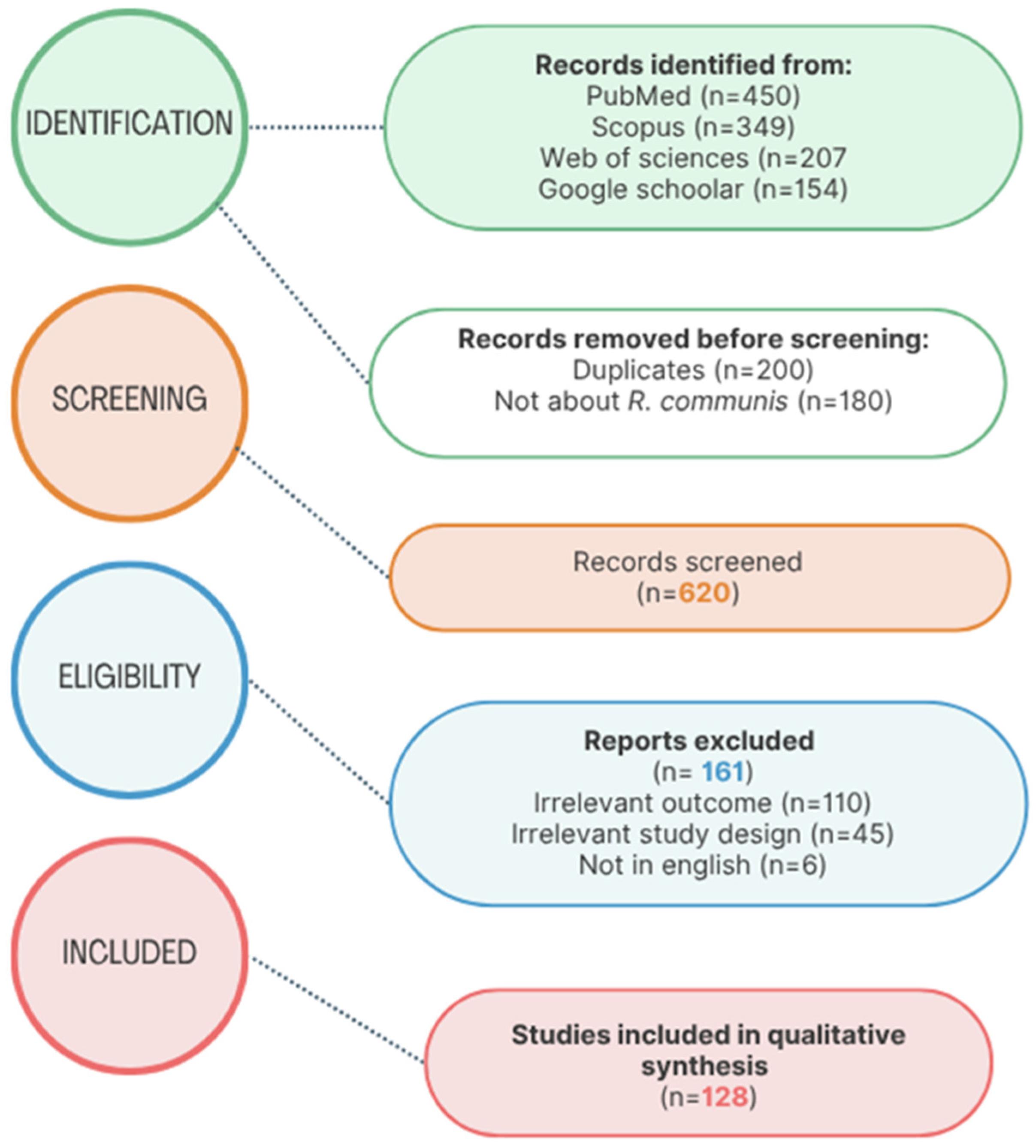
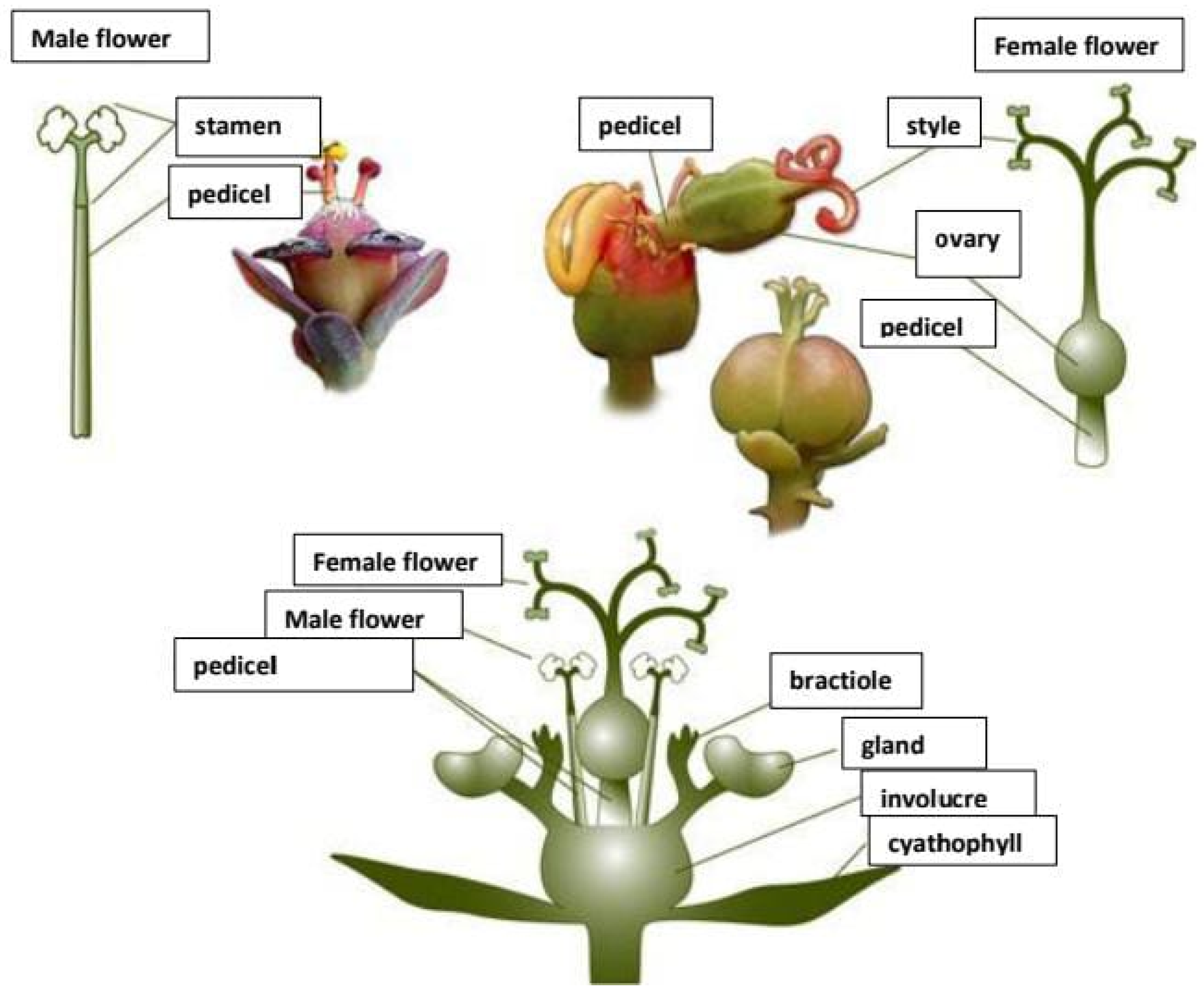
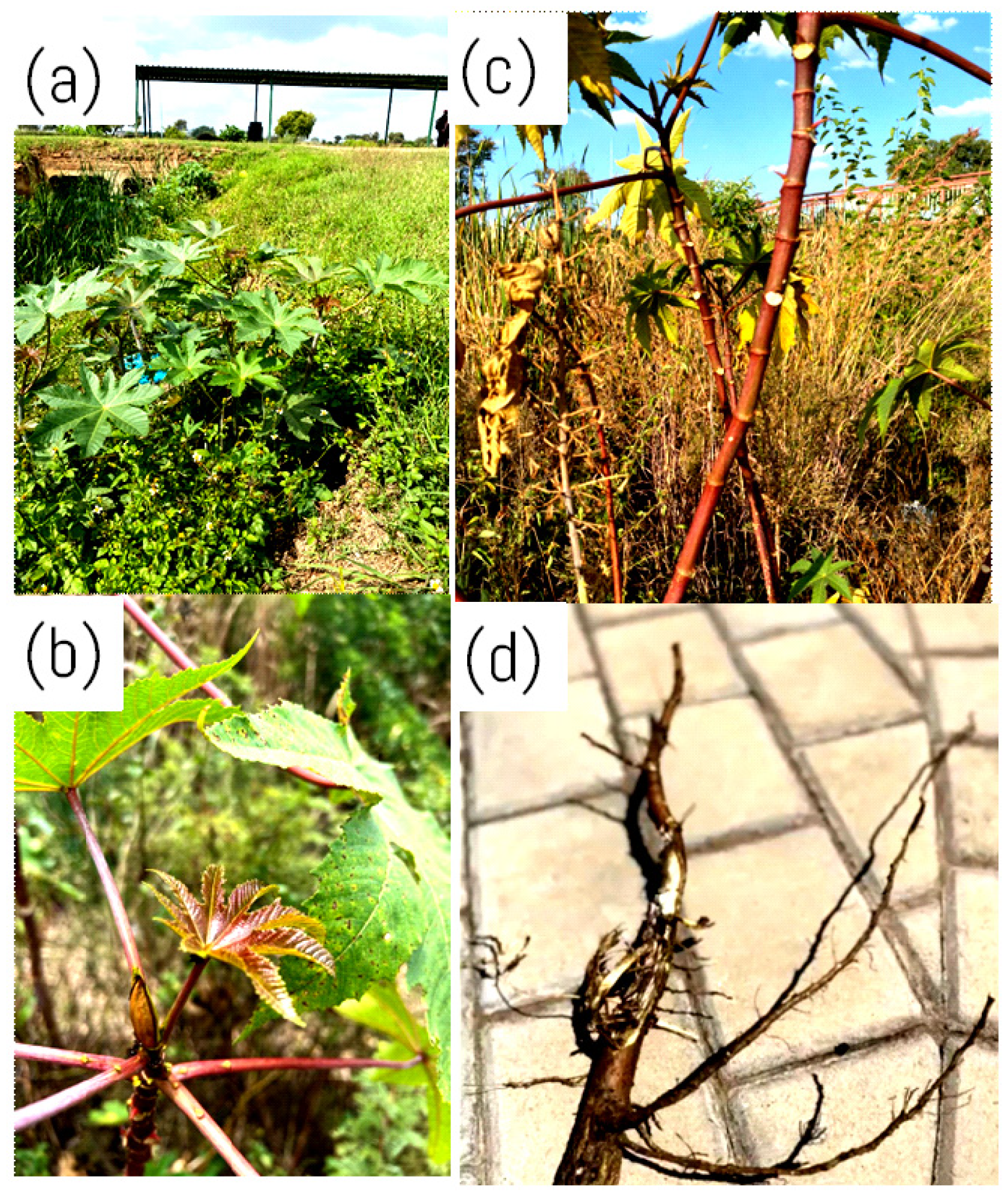
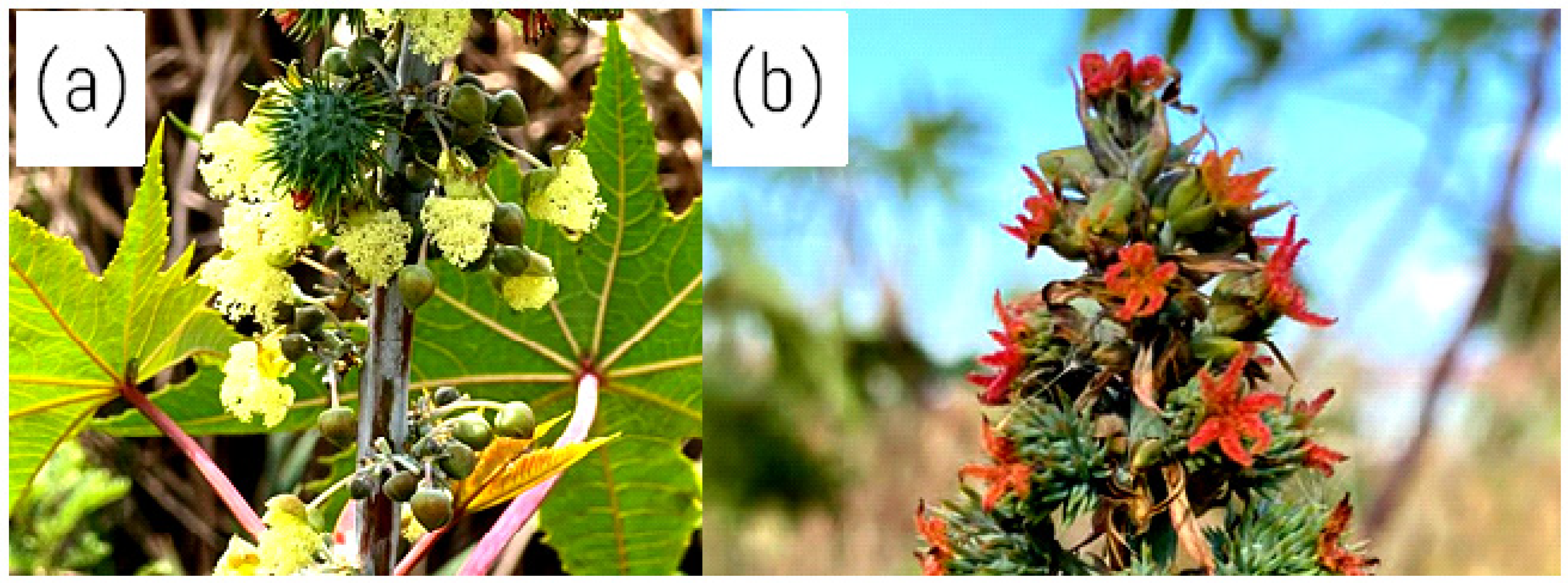
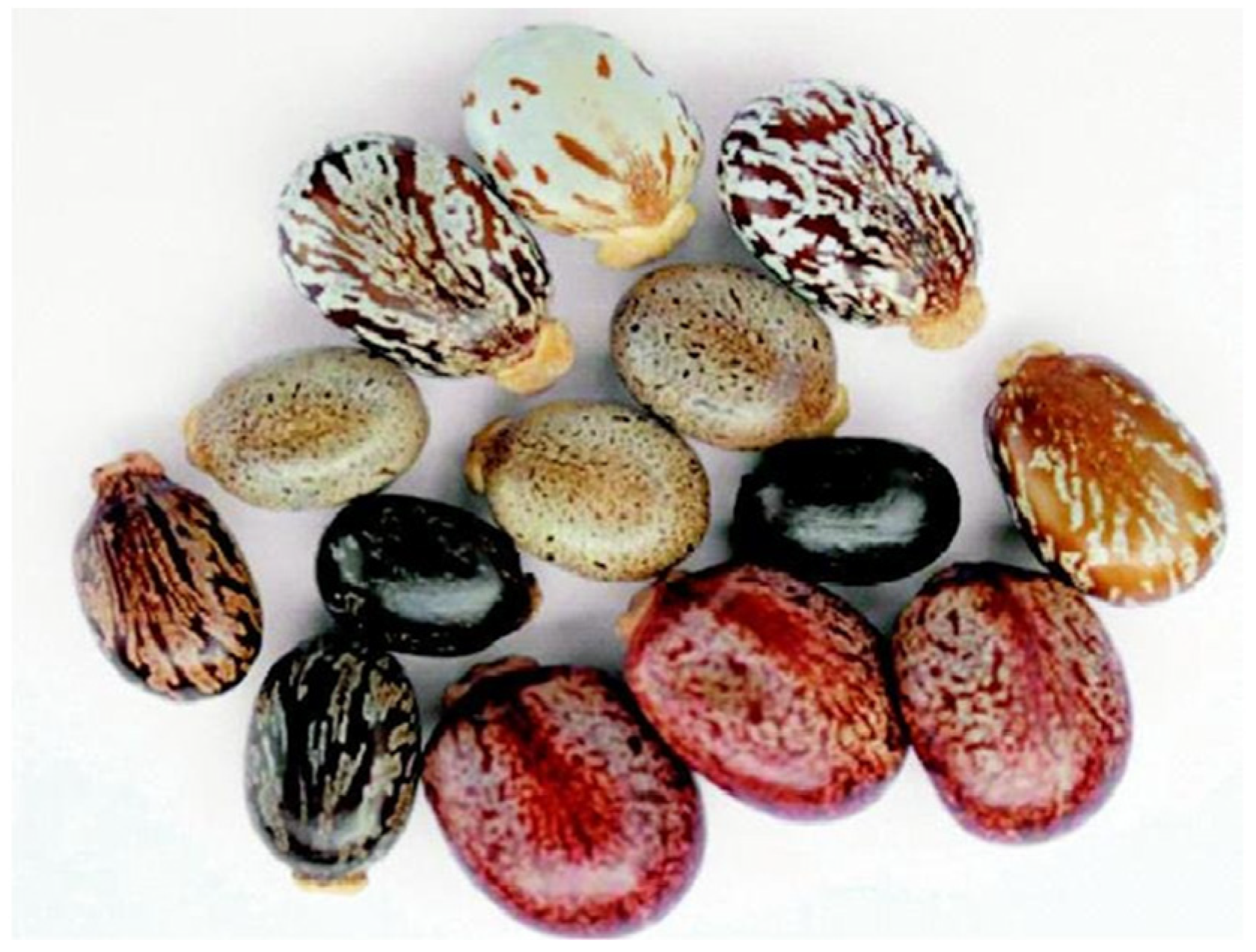
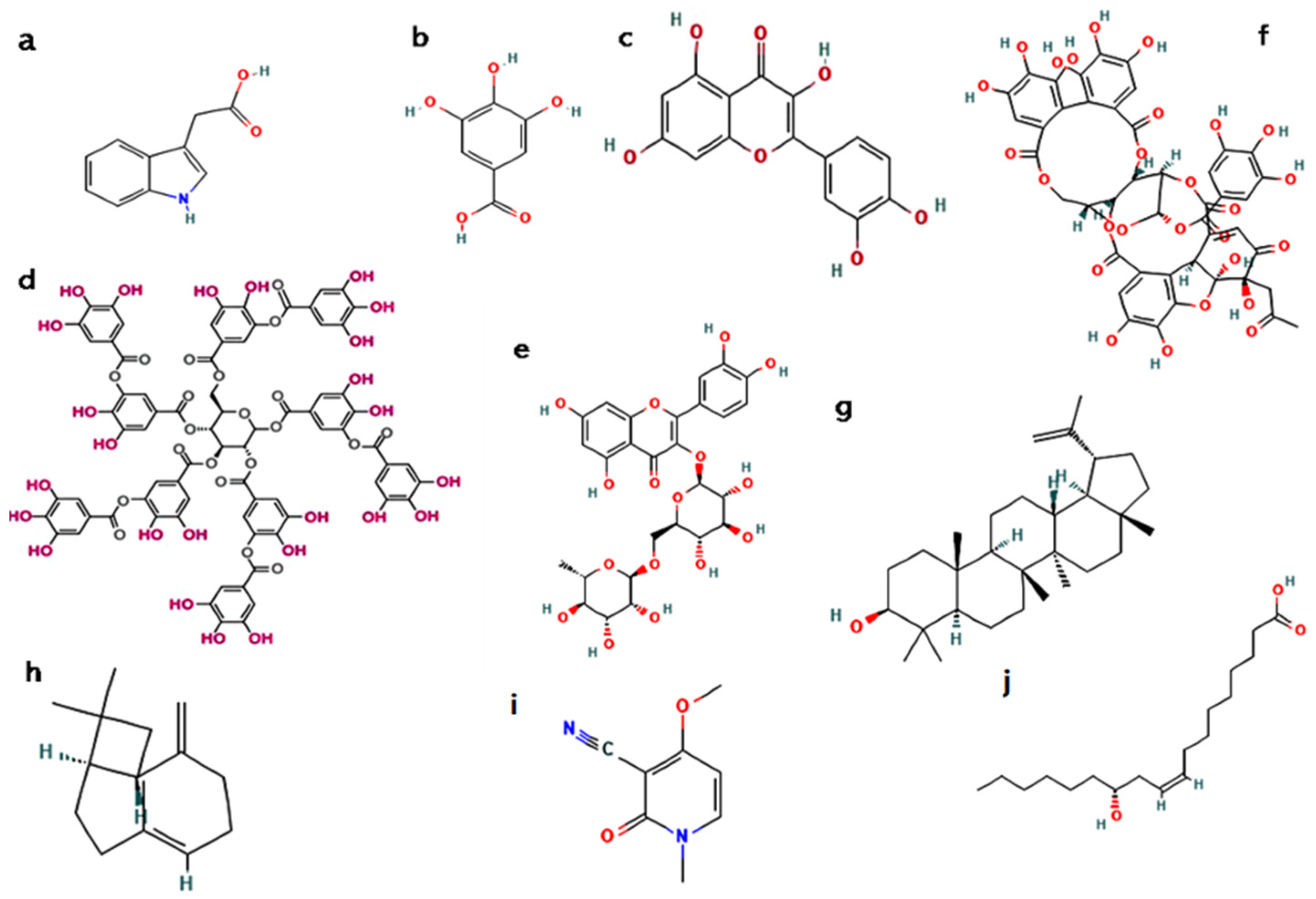
| Country | Climate | Soil type | References |
|---|---|---|---|
| Argentina | Temperate | Sandy or loamy soil | [65] |
| Brazil | Tropical and subtropical | Sandy or clay soil | [66] |
| China | Temperate and subtropical | Loamy soil | [67] |
| Egypt | Arid and subtropical | Sandy or clay soil | [68] |
| Ethiopia | Tropical and subtropical | Sandy or clay soil | [69] |
| India | Tropical | Alluvial, red, and black soil | [70] |
| Mexico | Tropical and subtropical | Various soil types | [71] |
| Nigeria | Tropical | Sandy or loamy soil | [72] |
| Pakistan | Arid and subtropical | Sandy or loamy soil | [73] |
| South Africa | Temperate and subtropical | Various soil types | [59] |
| United States | Temperate | Well-drained soil | [74] |
| Province | Habitat (of the Plant) | Soil Type | Climate/ Weather Conditions | References |
|---|---|---|---|---|
| Eastern Cape | Grasslands, scrublands | Sandy, clay | Variable | [60] |
| Gauteng | Disturbed areas (roadsides, fields) | Sandy, loamy | Temperate | [62] |
| Kwa-Zulu Natal | Coastal areas, riverbanks | Sandy, clay | Subtropical | [59,63] |
| Limpopo | Savanna, woodland | Sandy, loamy | Tropical | [59,63] |
| Mpumalanga | Savanna, woodland | Sandy, loamy | Subtropical | [63] |
| Northern Cape | Semi-desert regions | Sandy, rocky | Arid | [61] |
| Northwest | Grasslands, savanna | Sandy, clay | Arid to semi-arid | [75] |
| Western Cape | Fynbos biome, well-drained soils | Sandy, loamy | Mediterranean | [59] |
| Plant Part | Disease/Ailments | Treatment | References |
|---|---|---|---|
| Castor oil | Menstrual pain | Castor oil applied topically over the abdominal region helps relieve menstrual pain. | [81] |
| Inflammation | The topical application of castor oil is effective in reducing inflammation. | [81] | |
| Constipation | Consuming castor oil acts as an osmotic laxative, aiding in relieving constipation. | [76] | |
| Skin conditions | Applied topically for the treatments of skin conditions such as dermatitis, eczema, and acne | [4] | |
| Intestinal parasites | Ingested orally, typically warm or with herbs to expel intestinal worms and treat parasitic infections like Strongyloides and amoebiasis | [79,80] | |
| Leaves | Milk production | Leaves were fed to cattle to increase milk production and applied to women’s breasts for milk production. | [78,81] |
| Stomach ache | Drinking an infusion of castor leaves helps relieve stomach ache. | [78,81] | |
| Root | Jaundice | A hot water extract of dried roots taken orally for jaundice. | [81] |
| Seeds | Headaches | Applying a paste made from seeds on the forehead helps alleviate headaches. | [82] |
| Plant Part | Chemical Compound | Active Constituent | Reference |
|---|---|---|---|
| Leaves | Phenol | Gallic acid, ellagic acid, quercetin | [84,85,87] |
| Flavonoid | Rutin, epicatechin, isoquercetin | [84,85,87] | |
| Alkaloids | Ricinine | [84,85] | |
| Seeds (Fruits) | Flavonoid | Kaempferol | [11,86] |
| Tannin | Tannins | [11] | |
| Fatty acids | Ricin, ricinoleic acid | [2] | |
| Alkaloid | Ricinine | [2,11,86] | |
| Stems | Tannin | Tannins | [4] |
| Terpenoid | β-caryophyllene | [4] | |
| Roots | Indole derivative | Indole-3-acetic acid | [84] |
| Triterpenoid | Lupeol | [86] | |
| Flowers | Flavonoid | Rutin | [3,81] |
| Activity | Method | Mechanism | References |
|---|---|---|---|
| Antioxidant | Reducing power assay, DPPH scavenging activity assay, FRAP assay, ABTS scavenging assay | The presence of flavonoids and tannins contributes to antioxidant properties | [85,90,91] |
| Antimicrobial | Disc diffusion, MIC, Transmission Electron Microscopy | Broad-spectrum antimicrobial properties | [4,92,93,94] |
| Antidiabetic | Streptozocin-induced diabetic rat model, in vitro tests on insulin signalling pathways and glucose metabolism, analytical techniques for chemical composition | Reduction in blood glucose levels, improvement in insulin sensitivity, potential antidiabetic effects of penta-O-galloyl-β-D-glucose and castor oil | [10,95,96] |
| Anti-Inflammatory | Evaluation of Nrf2 activation, in vivo and in vitro models, microbiological assays | Activation of Nrf2 to mitigate muscular atrophy, antioxidant chemicals supporting anti-inflammatory activity | [10,97,98] |
| Anti-fertility | Intraperitoneal administration in male rats, semen analysis, oral administration in women volunteers | Reversible suppression of spermatogenesis and sperm motility, alteration in hormone levels associated with contraceptive effects | [100,101] |
| Anti-hepatotoxic | Evaluation of antioxidant activity, microbiological assays, toxicity experiments, animal models, biochemical testing | Reduction in oxidative stress, potential for liver protection, prevention of liver damage, hepatoprotective qualities | [102,103] |
| Anticancer | In vitro and in vivo models, molecular biology and cell culture techniques, histological investigations | Anti-tumour action, targeting of cancer stem cells and signalling pathways, and the potential use of ricin as a therapeutic agent | [10,11,58,104,105] |
| Antiparasitic | In vitro assay on Entamoeba histolytica cysts, in vivo assay on Caenorhabditis elegans, molecular docking, ADME profiling | Ricinoleic acid causes membrane disruption in protozoan cysts and inhibits helminth enzymes (succinate dehydrogenase, G6PD) | [80,106] |
| Plant Constituent | Industrial Sector | Application | Purpose | Reference |
|---|---|---|---|---|
| Castor Oil | Agriculture | Applied as a bio-based crop protection product | Acts as a natural pesticide, reducing reliance on synthetic chemicals for pest control | [3] |
| Biofuel production | Processed into biodiesel | Renewable energy source reduces dependence on fossil fuels | [107] | |
| Pharmaceuticals | Utilised in laxatives and potential drug delivery | Effective laxative properties, potential for controlled drug release | [89] | |
| Cosmetics | Added to skincare and haircare formulations | Emollient properties moisturise skin and hair and enhance product texture | [77] | |
| Lubricant and greases | Formulated into lubricants and greases | High viscosity, withstands high pressures and temperatures | [108] | |
| Ricinoleic acid | Plastic and polymer | Used in the synthesis of biodegradable plastics | Enhances sustainability, reduces environmental impact | [110] |
| Castor oil derivative | Industrial coatings and adhesives | Formulated into coatings and adhesives | Provides excellent adhesion and film-forming properties, enhances durability and corrosion resistance | [110,117] |
| Surfactants and emulsifiers | Serve as surfactants and emulsifiers | Stabilises emulsions enhance the dispersion of substances | [110,117] | |
| Textile | Used in sizing, dyeing, and finishing processes | It improves the texture, strength, and dyeability of textile fibres, and enhances the overall quality of textile products. | [117] |
| Compound | Animal Model | Route of Exposure | Reported LD50 | References |
|---|---|---|---|---|
| Ricin | Mouse (BALB/c) | Oral (gavage) | ~30 µg/kg | [125] |
| Rat | Inhalation | 0.24 µg/kg | [126] | |
| Mouse | Inhalation | 0.58 µg/kg | [126] | |
| Swine | Intramuscular | 5–10 µg/kg | [127] | |
| Ricinine | Mouse | Intraperitoneal | 340 mg/kg | [128] |
| Ricinus leaf aqueous extract | Mouse (Swiss) | Oral (crude) | No lethality at 2000 mg/kg | [124] |
Disclaimer/Publisher’s Note: The statements, opinions and data contained in all publications are solely those of the individual author(s) and contributor(s) and not of MDPI and/or the editor(s). MDPI and/or the editor(s) disclaim responsibility for any injury to people or property resulting from any ideas, methods, instructions or products referred to in the content. |
© 2025 by the authors. Licensee MDPI, Basel, Switzerland. This article is an open access article distributed under the terms and conditions of the Creative Commons Attribution (CC BY) license (https://creativecommons.org/licenses/by/4.0/).
Share and Cite
Ramothloa, T.P.; Mkolo, N.M.; Motshudi, M.C.; Mphephu, M.M.; Makhafola, M.A.; Naidoo, C.M. Phytochemical Composition and Multifunctional Applications of Ricinus communis L.: Insights into Therapeutic, Pharmacological, and Industrial Potential. Molecules 2025, 30, 3214. https://doi.org/10.3390/molecules30153214
Ramothloa TP, Mkolo NM, Motshudi MC, Mphephu MM, Makhafola MA, Naidoo CM. Phytochemical Composition and Multifunctional Applications of Ricinus communis L.: Insights into Therapeutic, Pharmacological, and Industrial Potential. Molecules. 2025; 30(15):3214. https://doi.org/10.3390/molecules30153214
Chicago/Turabian StyleRamothloa, Tokologo Prudence, Nqobile Monate Mkolo, Mmei Cheryl Motshudi, Mukhethwa Michael Mphephu, Mmamudi Anna Makhafola, and Clarissa Marcelle Naidoo. 2025. "Phytochemical Composition and Multifunctional Applications of Ricinus communis L.: Insights into Therapeutic, Pharmacological, and Industrial Potential" Molecules 30, no. 15: 3214. https://doi.org/10.3390/molecules30153214
APA StyleRamothloa, T. P., Mkolo, N. M., Motshudi, M. C., Mphephu, M. M., Makhafola, M. A., & Naidoo, C. M. (2025). Phytochemical Composition and Multifunctional Applications of Ricinus communis L.: Insights into Therapeutic, Pharmacological, and Industrial Potential. Molecules, 30(15), 3214. https://doi.org/10.3390/molecules30153214








